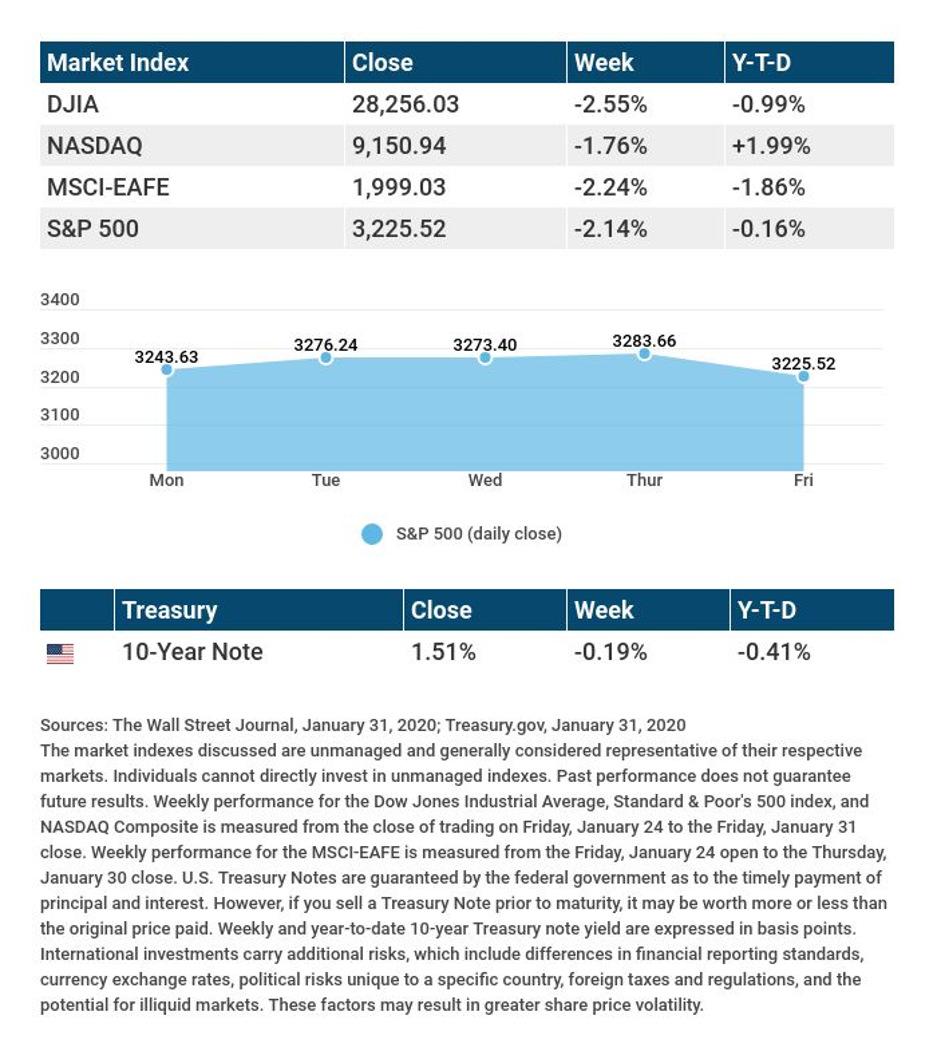The Week on Wall Street
Stock benchmarks declined for a second straight week as coronavirus news tempered risk appetite.
The S&P 500 fell 2.14% on the week. The Nasdaq Composite dipped 1.76%, and the Dow Jones Industrial Average, 2.55%. Away from North America, developed markets slumped 2.24%, according to MSCI’s EAFE index.[1][2]
The Fed Makes a Minor Move
The Federal Reserve left short-term interest rates alone at its January meeting, but it did make what Fed chairman Jerome Powell called a “small technical adjustment” in view of its continuing purchases of Treasuries. Wednesday, it slightly increased the interest rate paid to banks that park excess capital reserves at the Fed.
The move may give the Fed a bit more control over short-term rates this quarter and assist the operations of U.S. financial markets.[3]
Encouraging New Consumer Data
Rising to 131.6 in January, the Conference Board’s Consumer Confidence Index reached its highest level since August. Consumer spending increased 0.3% in December, according to a new Department of Commerce report.[4][5]
Economy Expanded at a 2.1% Pace in Fourth Quarter
The Bureau of Economic Analysis released this estimate Thursday. That number matches the gross domestic product of the third quarter and affirms that the U.S. avoided a fall slowdown.[6]
THE WEEK AHEAD: KEY ECONOMIC DATA
Monday: The latest snapshot of factory sector health from the Institute for Supply Management, presenting January data.
Wednesday: ISM’s January report on the state of non-manufacturing businesses and the latest private-sector payrolls report from Automatic Data Processing (ADP).
Friday: The Department of Labor releases its January employment report.
Source: MarketWatch, January 31, 2020
The MarketWatch economic calendar lists upcoming U.S. economic data releases (including key economic indicators), Federal Reserve policy meetings, and speaking engagements of Federal Reserve officials. The content is developed from sources believed to be providing accurate information. The forecasts or forward-looking statements are based on assumptions and may not materialize. The forecasts also are subject to revision.
THE WEEK AHEAD: COMPANIES REPORTING EARNINGS
Monday: Alphabet (GOOG), Sysco (SYY)
Tuesday: BP (BP), Fiserv (FISV), Gilead Sciences (GIL), Walt Disney (DIS)
Wednesday: GlaxoSmithKline (GSK), Merck (MRK), Qualcomm (QCOM), Toyota (TM)
Thursday: Bristol-Myers Squibb (BMY), Cigna (CI), Philip Morris (PM), Sanofi (SNY)
Friday: AbbVie (ABBV), Honda (HMC), Novo Nordisk (NVO)
Source: Zacks, January 31, 2020
Companies mentioned are for informational purposes only. It should not be considered a solicitation for the purchase or sale of the securities. Any investment should be consistent with your objectives, time frame and risk tolerance. The return and principal value of investments will fluctuate as market conditions change. When sold, investments may be worth more or less than their original cost. Companies may reschedule when they report earnings without notice.

Investing involves risk including the potential loss of principal. No investment strategy can guarantee a profit or protect against loss in periods of declining values.
Diversification does not guarantee profit nor is it guaranteed to protect assets.
International investing involves special risks such as currency fluctuation and political instability and may not be suitable for all investors.
The Standard & Poor’s 500 (S&P 500) is an unmanaged group of securities considered to be representative of the stock market in general.
The Dow Jones Industrial Average is a price-weighted average of 30 significant stocks traded on the New York Stock Exchange and the NASDAQ. The DJIA was invented by Charles Dow back in 1896.
The Nasdaq Composite is an index of the common stocks and similar securities listed on the NASDAQ stock market and is considered a broad indicator of the performance of stocks of technology companies and growth companies.
The MSCI EAFE Index was created by Morgan Stanley Capital International (MSCI) that serves as a benchmark of the performance in major international equity markets as represented by 21 major MSCI indices from Europe, Australia, and Southeast Asia.
The 10-year Treasury Note represents debt owed by the United States Treasury to the public. Since the U.S. Government is seen as a risk-free borrower, investors use the 10-year Treasury Note as a benchmark for the long-term bond market.
Opinions expressed are subject to change without notice and are not intended as investment advice or to predict future performance.
Past performance does not guarantee future results.
You cannot invest directly in an index.
Consult your financial professional before making any investment decision.
Fixed income investments are subject to various risks including changes in interest rates, credit quality, inflation risk, market valuations, prepayments, corporate events, tax ramifications and other factors.
These are the views of Platinum Advisor Strategies, LLC, and not necessarily those of the named representative, Broker dealer or Investment Advisor and should not be construed as investment advice. Neither the named representative nor the named Broker dealer or Investment Advisor gives tax or legal advice. All information is believed to be from reliable sources; however, we make no representation as to its completeness or accuracy. Please consult your financial advisor for further information.
By clicking on these links, you will leave our server, as the links are located on another server. We have not independently verified the information available through this link. The link is provided to you as a matter of interest. Please click on the links below to leave and proceed to the selected site.

